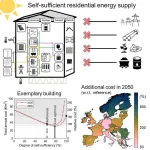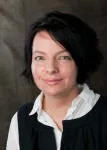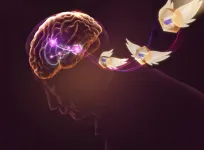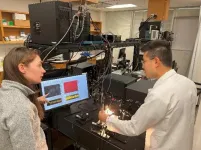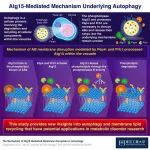(Press-News.org) Researchers report that 53% of European freestanding homes could have supplied all their own energy needs in 2020 using only local rooftop solar radiation, and this technical feasibility could increase to 75% in 2050. Publishing November 2 in the journal Joule, the study shows that there is no economic advantage for individual households to be fully self-sufficient under current or future conditions, though in some cases the costs are on par with remaining on-grid. The researchers estimate that self-sufficiency will be economically feasible for 5% (two million) of Europe’s 41 million freestanding single-family homes in 2050, if households are willing to pay up to 50% more than the cost of remaining fully grid dependent.
“Our results show that even in 2050 going off-grid won’t be the most economic choice, but it could make sense to invest in these kinds of self-sufficient buildings if you are willing to pay more for self-sufficiency,” says lead author Max Kleinebrahm, an energy economics researcher at the Karlsruhe Institute of Technology in Germany.
Grid energy costs are rising while renewable energy technology is becoming more affordable. In pursuit of self-sufficiency, more and more households are showing interest in producing their own renewable energy supplies. Kleinebrahm’s team wanted to know how feasible it would be for individual residential buildings in different parts of Europe to become fully self-sufficient, and whether doing so would come with any financial benefits. Though the potential of converting Europe to 100% renewable energy has been considered at the continental, national, and regional scale, this study is the first analysis at the level of individual buildings.
To identify regions and building types that are more amenable to self-sufficiency, the researchers compiled a database of homes across Europe and identified 4,000 homes that were representative of different regions in terms of architecture, household electricity demand, climate conditions, and the local economic framework. Then, the researchers designed optimal energy systems for each representative home that would fully cover electrical and thermal energy needs while minimizing costs. These systems included measures such as rooftop solar panels, small wind turbines, different types of storage systems, heat pump installation, and retrofitting and insulation measures.
Next, the researchers scaled their results up to estimate the technical and economic feasibility of energy self-sufficiency for Europe’s 41 million freestanding single-family homes. Overall, they estimated that 53% of homes could have technically achieved energy self-sufficiency in 2020, and that this proportion could increase to 75% by 2050 with expected improvements in renewable energy and storage technologies. However, becoming fully self-sufficient was more expensive than remaining fully dependent on the grid, both in 2020 and 2050.
Homes in sunny European countries such as Cyprus, Malta, and Italy have more economic potential for self-sufficiency, while northern European countries such as Finland, Norway, and Sweden (where there is a large mismatch between high winter energy needs and solar radiation) have the lowest potential. Regions with larger rooftops, such as Denmark, Slovenia, the Netherlands, and France, also have greater potential for self-sufficiency. The researchers also noted that there is greater potential for self-sufficient buildings in countries with high on-grid electricity costs, such as Germany, since there is less financial incentive to remain on-grid.
Though becoming fully self-sufficient may not be economically advantageous, the researchers demonstrated that partial self-sufficiency—where a building remains connected to the electricity grid but also invests in a photovoltaic system, heat pump, and insulation—could lower household energy costs. The optimal degree of self-sufficiency varied for different buildings and regions, but for one representative building in Germany, the researchers estimated that it would have been cost-optimal to be 73% self-sufficient in 2020 and 78% self-sufficient in 2050.
The researchers note that high carrier costs make leaving the grid more appealing and say that policymakers and utility companies should encourage even fully self-sufficient households to remain connected to the grid. “At a macroeconomic scale it would be less efficient to have a large number of households abandoning the grid rather than supporting it,” says Kleinebrahm.
Since the costs of supporting the grid are shared amongst users, there is also the potential for grid costs to climb further as households choose to leave the grid. “From the social perspective, you have to consider the possibility that very rich households could go off grid, in which case the rest of the grid operation would have to be paid for by economically weaker households,” says Kleinebrahm.
This study is unable to answer questions about how the expanding number of self-sufficient homes would impact electricity demand and electricity markets, but the researchers plan to address those topics in future.
###
This research was supported by the Helmholtz Association.
Joule, Kleinebrahm et al., “Two million European single-family homes could abandon the grid by 2050” https://www.cell.com/joule/fulltext/S2542-4351(23)00402-6
Joule (@Joule_CP), published monthly by Cell Press, is a new home for outstanding and insightful research, analysis, and ideas addressing the need for more sustainable energy. A sister journal to Cell, Joule spans all scales of energy research, from fundamental laboratory research into energy conversion and storage to impactful analysis at the global level. Visit http://www.cell.com/joule. To receive Cell Press media alerts, contact press@cell.com.
END
All-nighters can cause giddy and slap-happy feelings
This effect is caused by increased dopamine release in distributed brain regions
This dopamine signal also enhances plasticity in the neuronal connections, causing a potent antidepressant effect that lasts for days
Study suggests that prefrontal cortex and its dopamine inputs are key for rapid plasticity and antidepressant effects after brief sleep loss
EVANSTON, Ill. — Most people who have pulled an all-nighter are all too familiar with that “tired and wired” ...
Researchers from the Shenzhen Institute of Advanced Technology (SIAT) of the Chinese Academy of Sciences (CAS) and their collaborators have developed a gene therapy strategy to selectively manipulate Parkinson's disease-affected circuitry and attenuate the core motor symptoms of Parkinson's disease in rodent and nonhuman primate animals.
The study was published in Cell on Nov. 2.
Parkinson's disease, characterized by the loss of midbrain dopaminergic neurons, is one of the most common neurodegenerative diseases in the elderly population, affecting more than 6 million people worldwide.
Dopamine ...
Women who receive a false positive mammography result are more likely to develop breast cancer over the subsequent 20 years, report researchers from Karolinska Institutet in a study published in JAMA Oncology. The risk is highest for women aged between 60 and 75 and who have low breast density.
In global terms, breast cancer is the most common form of cancer among women, and screening is an important tool for catching women with a tumour at the earliest possible stage. In Sweden, all women between ...
About The Study: In this study of 274 midlife women, greater posttraumatic stress disorder (PTSD) symptoms were associated with higher carotid atherosclerosis and, among women who were APOEɛ4 carriers, greater brain small vessel disease and poorer cognitive performance. These findings point to the adverse implications of PTSD symptoms for cardiovascular and neurocognitive health among women in midlife, particularly for women who are APOEɛ4 carriers.
Authors: Rebecca C. Thurston, Ph.D., of the University of Pittsburgh, is the corresponding author.
To access the embargoed ...
About The Study: The findings of this study suggest that the risk of developing breast cancer after a false-positive mammography result differs by individual characteristics and follow-up. These findings can be used to develop individualized risk-based breast cancer screening after a false-positive result.
Authors: Xinhe Mao, M.Sc., of the Karolinska Institutet in Stockholm, is the corresponding author.
To access the embargoed study: Visit our For The Media website at this link https://media.jamanetwork.com/
(doi:10.1001/jamaoncol.2023.4519)
Editor’s Note: Please ...
PROVIDENCE, R.I. [Brown University] — Practicing mindfulness focused on healthy eating can be good for the heart, a new study shows, because it improves self-awareness and helps people stick to a heart-healthy diet.
When people who had elevated blood pressure participated in an eight-week mindfulness-based blood pressure reduction program for the study, they significantly improved their scores on measures of self-awareness and adherence to a heart-healthy diet compared to a control group. The results were published in JAMA Network Open.
“Participants ...
NEW ORLEANS, LA- Ochsner Health, the leading healthcare system in the Gulf South, and Infirmary Health, Alabama's largest private non-profit healthcare provider, are proud to announce a landmark partnership with Ochsner Accountable Care Network, a top-performing accountable care organization (ACO) in both clinical performance and healthcare savings for the Medicare population. The partnership aims to improve health outcomes for seniors across the Gulf Coast region.
Infirmary Health's hospitals and acute care facilities are recognized as national leaders in innovative and compassionate care for ...
WASHINGTON — Researchers have developed a new optical coherence tomography (OCT) approach that can directly image coordination of tiny hair-like structures known as motile cilia in their natural environment. The ability to observe cilia dynamics in living organisms gives researchers a powerful new tool to investigate how these structures move cells and substances through the female reproductive system, as well as other functions of cilia throughout the body.
“Our new method has the potential to answer the longstanding question about cilia's ...
Recycling is just as essential in cells as in our more familiar macroscopic world. Cells continuously generate waste products and accumulate damaged components while performing regular functions. Various recycling mechanisms have evolved to ensure efficient use of these resources and help maintain homeostasis, with autophagy being one of the most well-preserved among countless animal, plant, and fungal lineages.
In the main form of autophagy, materials floating in the cell are transported to specialized organelles, such as lysosomes or vacuoles, within small capsule-like structures called ...
Mutations in the PIK3CA gene that lead to elevated production of the PI3Ka protein are among the most frequent alterations found in cancer, including in approximately 40% of hormone receptor–positive breast cancers.
Alpelisib, the first drug targeting PI3Ka, was approved for use in the United States four years ago, but cancers with mutated PIK3CA eventually develop resistance to the medication.
A team led by investigators at the Mass General Cancer Center, a member of the Mass General Brigham healthcare system, recently identified that resistance in some cases can be caused by secondary mutations in the PIK3CA gene itself. This leads ...
